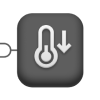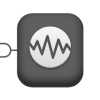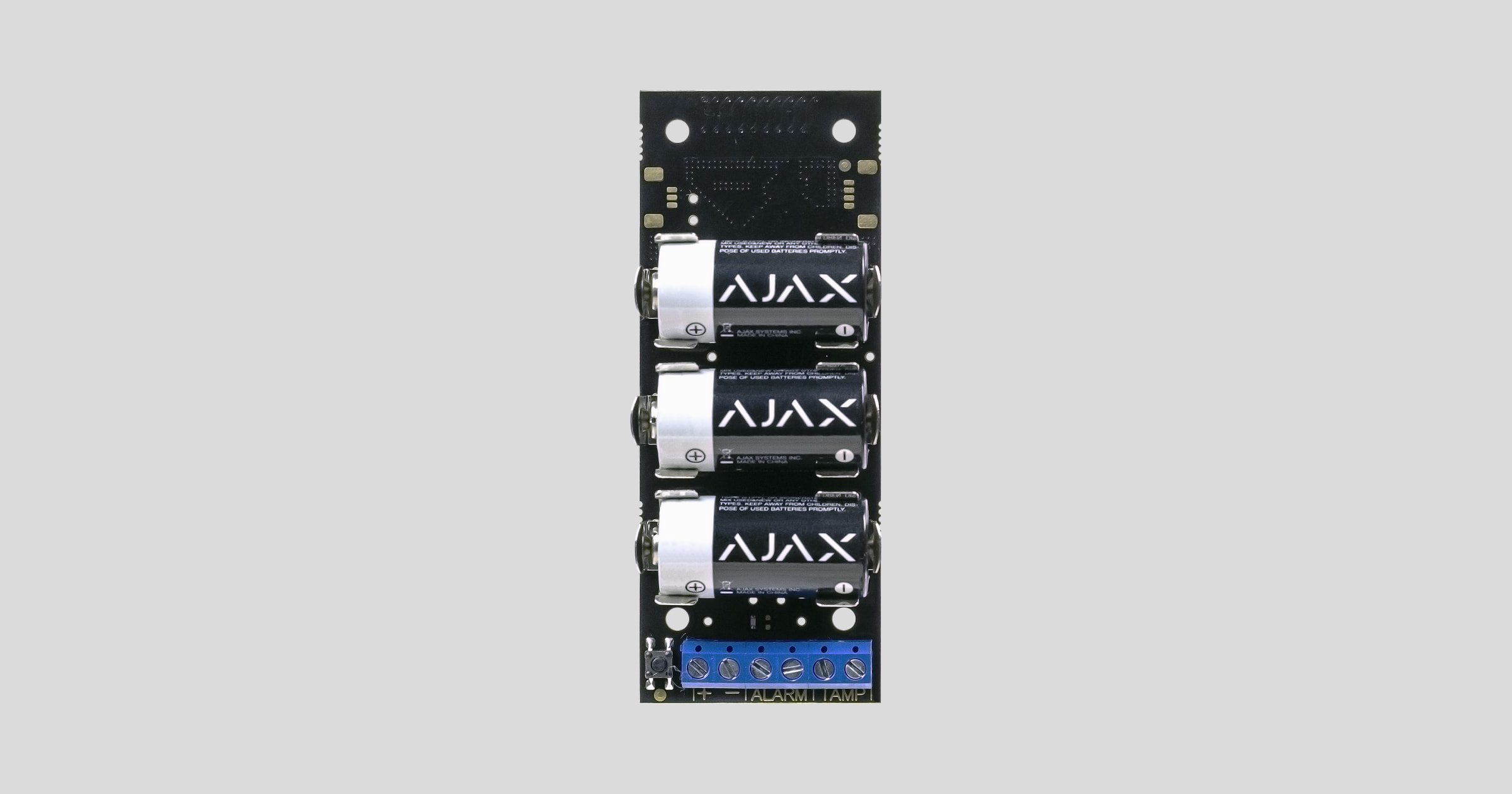Transmitter is a module for connecting third-party detectors to Ajax security system. It transmits alarms and notifies when the tamper of the third-party detector triggers. The module is equipped with its own accelerometer, which protects it from dismounting. It runs on batteries and can supply power to the connected detector.
Transmitter operates within the Ajax security system, by connecting via the protected Jeweller protocol to the hub. It is not intended to use the device in third-party systems.
Not compatible with the uartBridge or ocBridge Plus
The communication range can be up to 1,600 meters provided that there are no obstacles and the case is removed.
Transmitter is set up via a mobile application for iOS and Android based smartphones.
Functional Elements
- QR code with the device registration key.
- Batteries contacts.
- LED indicator.
- ON/OFF button.
- Terminals for detector power supply, alarm, and tamper signals.
Operation procedure
Transmitter is designed to connect third-party wired sensors and devices to the Ajax security system. The integration module receives information about alarms and tamper activation through the wires connected to the clamps.
Transmitter can be used to connect panic and auxiliary request buttons, indoor and outdoor motion detectors, as well as opening, vibration, breaking, fire, gas, leakage, and others wired detectors.
Also, you can set up KeyArm Zone that allows switching system arming modes with a third-party device connected to Transmitter. KeyArm allows you to arm/disarm the system, individual groups, or manage Night Mode.
The KeyArm feature is supported by all hubs (except Hub model) with OS Malevich 2.17 and higher.
The type of alarm is indicated in the settings of Transmitter. The text of notifications about alarms and events of the connected device, as well as event codes transmitted to the central monitoring panel of the security company (CMS) depend on the selected type.
Event types of wired devices
| Type | Icon | Meaning |
| Intrusion |
 |
Alarm when motion, or opening, or other detectors trigger. |
| Fire |
 |
Alarm when fire detectors trigger. |
| Auxiliary alarm |
 |
Alarm when pressing auxiliary request button. |
| Panic button |
 |
Alarm when pressing the panic button. |
| Gas alarm |
 |
Alarm when gas concentration is exceeded. |
| Malfunction |
 |
Notification of the connected device malfunction. Transmitter should be connected to Hub Plus, Hub 2 (2G), Hub 2 (4G), Hub 2 Plus, Superior Hub Hybrid (2G) or Superior Hub Hybrid (4G) with the OS Malevich 2.13.0 firmware version and higher. |
| Leakage |
 |
Alarm when water leakage detectors trigger. |
| Glass break |
 |
Alarm when the glass break sensor is triggered. This event type operates only in Pulse operating mode. |
| High temperature |
 |
Alarm when the upper temperature limit is exceeded. |
| Low temperature |
 |
Alarm when the lower temperature limit is exceeded. |
| Masking |
 |
Alarm when the device masking is detected. |
| Duress code (opening) |
 |
Alarm when the duress code is entered. This event type operates only in Pulse operating mode. |
| Vibration (seismic sensor) |
 |
Alarm when the seismic sensor is triggered. This event type operates only in Pulse operating mode. |
| Custom |
 |
The type of event that is configured by the user. It is not sent to the security company monitoring station. Transmitter should be connected to Hub Plus, Hub 2 (2G), Hub 2 (4G), Hub 2 Plus, Superior Hub Hybrid (2G) or Superior Hub Hybrid (4G) with the OS Malevich 2.13.0 firmware version and higher. |
Transmitter has 2 pairs of wired zones: alarm and tamper.
A separate pair of terminals ensures power supply to the external detector from the module batteries with 3.3 V.
Connecting to the hub
Before starting connection
- Following the hub instruction recommendations, install the Ajax application on your smartphone. Create an account, add the hub to the application, and create at least one room.
- Go to the Ajax application.
- Switch on the hub and check the internet connection (via Ethernet cable and/or GSM network).
- Ensure that the hub is disarmed and does not start updates by checking its status in the mobile application.
Only users with administrative privileges can add the device to the hub
How to connect Transmitter to the hub
- Select the Add Device option in the Ajax application.
- Name the device, scan or enter manually the QR code (located on the body and packaging), and select the location room.
- Select Add — the countdown will begin.
- Switch on the device (by pressing on/off button for 3 seconds).
For the detection and interfacing to occur, the device should be located within the coverage area of the wireless network of the hub (at a single protected object).
Request for connection to the hub is transmitted for a short time at the time of switching on the device.
If the connection to the Ajax hub failed, Transmitter will switch off after 6 seconds. You may repeat the connection attempt then.
Transmitter connected to the hub will appear in the list of devices of the hub in the application. Update of device statuses in the list depends on the device inquiry time set in the hub settings, with the default value – 36 seconds.
Icons
The icons display some of the Transmitter Jeweller states. To access them:
- Sign in to the Ajax app.
- Select the space.
- Go to the Devices
tab.
| Icon | Meaning |
|
Jeweller signal strength — displays the signal strength between the hub and the integration module. The recommended value is 2–3 bars. |
|
|
Charge level of the integration module battery. |
|
| The integration module operates through a radio signal range extender. | |
|
The device is in the signal attenuation test mode. |
|
|
Transmitter Jeweller is permanently deactivated. |
|
|
Transmitter Jeweller is disabled until the system is first disarmed. |
|
| The device has lost connection with the hub or the hub has lost connection with the Ajax Cloud server. | |
|
The device has not been transferred to the new hub. |
|
| The sensor operates in the Switch arming modes mode. | |
| Icons of modes and event types when the sensor operates in the Detect alarms mode | |
|
Chime function is enabled. |
|
|
Delay When Entering and/or Leaving is enabled. |
|
|
The device operates in the Always active mode. |
|
|
The device will operate when Night Mode is enabled. |
|
| Type of event Intrusion is selected. | |
| Intrusion alarm. | |
|
The detector has tamper triggering events permanently deactivated. |
|
|
Transmitter Jeweller has tamper triggering events deactivated for a time the armed mode is active. |
|
| Type of event Fire is selected. | |
| The device has detected a fire alarm. | |
| Type of event Auxiliary alarm is selected. | |
| Alarm when the auxiliary button is pressed. | |
| Type of event Panic button is selected. | |
| Alarm when the panic button is pressed. | |
| Type of event Gas alarm is selected. | |
| Alarm when the gas concentration is exceeded. | |
| Type of event Malfunction is selected. | |
| Device malfunction is detected. | |
| Type of event Leakage is selected. | |
| Alarm caused by the flooding. | |
| Type of event Custom is selected. | |
| The device has been triggered. | |
| Type of event Glass break is selected. | |
| Glass break alarm. | |
| Type of event High temperature is selected. | |
| Alarm when the upper temperature limit is exceeded. | |
| Type of event Low temperature is selected. | |
| Alarm when the lower temperature limit is exceeded. | |
| Type of event Masking is selected. | |
| Masking alarm. | |
| Type of event Duress code (opening) is selected. | |
| Alarm caused by the system disarming using the duress code device. | |
| Type of event Vibration (seismic sensor) is selected. | |
| Vibration (seismic) alarm. | |
States
The states screen contains information about the device and its current parameters. The statuses of Transmitter and the device connected to it can be found in the Ajax app:
- Go to the Devices
tab.
- Select Transmitter from the list.
| Parameter | Meaning |
| Data import | Displays the error when transferring data to the new hub:
|
| Temperature |
Temperature of the device. Measured on the processor and changes gradually. Acceptable error between the value in the app and the room temperature — 2°C. The value is updated as soon as the detector identifies a temperature change of at least 2°C. You can configure a scenario by temperature to control automation devices. |
| Jeweller Signal Strength |
Signal strength between the hub/range extender and Transmitter. We recommend installing the detector in places where the signal strength is 2–3 bars. |
| Connection via Jeweller | Connection status between the hub/range extender and device:
|
| Transmitter power |
Displays the selected power of the transmitter. The parameter appears when the Max or Attenuation option is selected in the Signal attenuation test menu. |
| ReX range extender name | Indicates if Transmitter is connected via a radio signal range extender. |
| Battery Charge |
Battery level of the device. Displayed as a percentage. |
| Lid | Device tamper zone status. |
|
External sensor state (displayed when the detector is in bistable mode only) |
Displays the status of the connected detector alarm zone. Two statuses are available:
|
| Alert if Moved | It turns on the built-in accelerometer, detecting device movement. |
| Always Active |
When this option is enabled, the integration module is constantly armed and notifies about the connected detector alarms. |
| Chime activation |
When the function is enabled, the sirens connected to the system notify about the triggering of the opening detectors integrated with the help of Transmitter, while the system is disarmed. |
| Permanent Deactivation | Shows the status of the device permanent deactivation function:
|
| Alarm Reaction | |
| Operating Mode | Shows how the detector reacts to alarms:
|
| Delay When Entering, s |
Entry delay (alarm activation delay) is the time you have to disarm the security system after entering the room. |
| Delay When Leaving, s |
Delay time when exiting. Delay when exiting (alarm activation delay) is the time you have to exit the room after arming the security system. |
| Night mode Delay When Entering, s |
The time of Delay When Entering in the Night mode. Delay when entering (alarm activation delay) is the time you have to disarm the security system after entering the premises. |
| Night mode Delay When Leaving, s |
The time of Delay When Leaving in the Night mode. Delay when leaving (alarm activation delay) is the time you have to exit the premises after the security system is armed. |
| Firmware | Detector firmware version. |
| Device ID | Device identifier. |
| Device No. | Number of the device loop (zone). |
Settings
To change the Transmitter settings in the Ajax app:
- Go to the Devices
tab.
- Select Transmitter from the list.
- Go to Settings by clicking on the
.
- Set the required parameters.
- Click Back to save the new settings.
| Setting | Meaning |
| Name |
Detector name that can be changed. The name is displayed in the text of SMS and notifications in the event feed. The name can contain up to 12 Cyrillic characters or up to 24 Latin characters. |
| Room | Selecting the virtual room to which Transmitter is assigned. The name of the room is displayed in the text of SMS and notifications in the event feed. |
| Power Supply for Connected Detectors | 3.3 V power-on for a third-party wired detector:
If the Always Active mode is enabled, the third-party detector power supply is on in the Always Active or Disabled if not Armed modes only, regardless of the security system status. |
| External Detector Contact Status | Selection of the external detector normal status:
|
| External Detector Type | Selection of the external detector type:
|
| Sensor Mode | Selecting the sensor mode of the connected device:
|
| Type of event |
Selecting an event type for the connected detector or device. Refer to the Event types of wired devices section for more information. The texts of notifications in the event feed and SMS, as well as the code transmitted to the security company monitoring station, depend on the selected type of event. This setting is available if Notify of Alarms option is selected for the Sensor Mode setting. |
| Arm Switch Settings | Configuring the arm switch if the Switch Arming Modes option is selected for the Sensor Mode setting:
Enable the Notify of attempts to use arm switch when it’s locked feature to receive notifications for every attempt to switch arming mode with a locked arm switch. When locked, it cannot switch modes. |
| Tamper status | Selection of the normal tamper mod for an external detector:
|
| Alert If Moved | Enabling the built-in accelerometer to receive an alarm in case of device movement. |
| Always Active |
When this option is enabled, the integration module is constantly armed and notifies about the connected detector alarms. This setting is available if Notify of Alarms option is selected for the Sensor Mode setting. |
| Alert with a siren if alarm detected | If enabled, the sirens added to the system are activated if an alarm is detected. |
| Alert with a siren if accelerometer triggered | If enabled, the sirens added to the system are triggered if device movement is detected. |
| Chime Settings |
Opens the settings of Chime. |
| Alarm Reaction | |
| Operating Mode | Specify how this device will react to alarms:
|
| Delay When Entering, s |
Selecting delay time when entering. Delay when entering (alarm activation delay) is the time you have to disarm the security system after entering the room. |
| Delay When Leaving, s |
Selecting the delay time when exiting. Delay when exiting (alarm activation delay) is the time you have to exit the room after arming the security system. |
| Arm in Night Mode | If enabled, the detector connected to the integration module will switch to the armed mode when using the Night mode. |
| Night mode Delay When Entering, s |
The time of Delay When Entering in the Night mode. Delay when entering (alarm activation delay) is the time you have to disarm the security system after entering the premises. |
| Night mode Delay When Leaving, s |
The time of Delay When Leaving in the Night mode. Delay when leaving (alarm activation delay) is the time you have to exit the premises after the security system is armed. |
| Jeweller Signal Strength Test |
Switches Transmitter to the Jeweller signal strength test mode. |
| Signal Attenuation Test |
Switches Transmitter to the signal fade test mode (available in device with firmware version 3.50 and later). |
| User Guide | Opens the Transmitter User Manual in the Ajax app. |
| Permanent Deactivation | Three options are available:
Learn more about device permanent deactivation The system can also automatically deactivate devices when the set number of alarms is exceeded or when the recovery timer expires. |
| One-Time Deactivation |
Allows the user to disable events of the device until the first event of disarming the system. Three options are available:
|
| Unpair Device | Disconnects the device from the hub and deletes its settings. |
How to set Chime
Chime is a sound signal that indicates the triggering of the opening detectors when the system is disarmed. The feature is used, for example, in stores, to notify employees that someone has entered the building.
Notifications are configured in two stages: setting up opening detectors and setting up sirens.
Transmitter settings
Before setting up the Chime feature, make sure that a wired opening detector is connected to Transmitter and the following options have been configured in the detector settings in the Ajax app:
- Detector power supply
- External Detector Contact Status
- External Detector Type
- Type of event
- Tamper status
- Go to the Devices
menu.
- Select Transmitter.
- Go to its settings by clicking the gear icon
in the upper right corner.
- Go to the Chime Settings menu.
- Select siren notification for the event If external contact is open.
- Select the chime sound: 1 to 4 beeps. Once selected, the Ajax app will play the sound.
- Click Back to save the settings.
- Set up the required siren.
Indication
| Event | Indication |
| The Module is switched on and registered | The LED lights up when the ON button is briefly pressed. |
| Registration failed | The LED blinks for 4 seconds with an interval of 1 second, then blinks 3 times rapidly (and automatically switches OFF). |
| The Module is deleted from the list of hub devices | The LED blinks for 1 minute with an interval of 1 second, then blinks 3 times rapidly (and automatically switches OFF). |
| The Module has received alarm/tamper signal | The LED lights up for 1 second. |
| Batteries are discharged | Smoothly lights up and goes out when the detector or tamper is activated. |
Performance testing
The Ajax system allows conducting tests for checking the functionality of connected devices.
The tests do not start straight away, but within a period of 36 seconds when using the standard settings. The test time start depends on the settings of the detector scanning period (the paragraph on Jeweller settings in hub settings).
Connection of the Module to the wired detector
Transmitter location determines its remoteness from the hub and presence of any obstacles between the devices hindering the radio signal transmission: walls, inserted floors, large-size objects located within the room.
Check the signal strength level at the installation location
If the signal level is one division, we cannot guarantee stable operation of the security system. Take possible measures to improve the quality of the signal. At least, move the device with an integration module — even a 20 cm shift can significantly improve the signal strength.
If after moving, the device still has a low or unstable signal strength, use a radio signal range extender.
Transmitter should be installed inside the wired detector case. The module requires a space with the following minimum dimensions: 110 × 41 × 24 mm. If the installation of Transmitter within the detector case is impossible, then any available radiotransparent case could be used.
- Connect Transmitter to the detector through the NC/NO contacts (choose the relevant setting in the app) and COM.
The maximum cable length for connecting the sensor is 130 m (24 AWG twisted pair). The value may vary when using different type of cable.
The function of the terminals of Transmitter
- “+ —” — power terminals of the connected wired device, the output voltage is 3.3 V⎓.
- ALARM — alarm terminals of the device.
- TAMP — terminals of the device tamper.
Do not connect a third-party power supply unit to the power terminals. This may damage the device
-
Secure Transmitter in the casing. Plastic bars are included in the installation kit. It is recommended to install Transmitter on them. Fix Transmitter using a double-sided tape. Double-sided tape should be UL Recognized to UL 746C for the application surface and end-use application standard.
Do not install Transmitter:
- Near metal objects and mirrors (they can shield the radio signal and lead to its attenuation).
- Closer than 1 meter to a hub.
Maintenance and Battery Replacement
The device does not require maintenance when mounted in the housing of a wired sensor.
Technical specifications
Complete Set
- Transmitter.
- Battery CR123A — 3 pcs.
- Installation kit.
- Quick start guide.
Warranty
Warranty for the Limited Liability Company “Ajax Systems Manufacturing” products is valid for 2 years after the purchase and does not apply to the pre-installed battery.
If the device does not work correctly, you should first contact the support service — in half of the cases, technical issues can be solved remotely!
Contact Technical Support:




